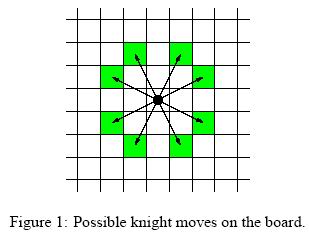Knight Moves
| Time Limit: 1000MS | Memory Limit: 30000K | |
| Total Submissions: 18211 | Accepted: 8335 |
Description
Background
Mr Somurolov, fabulous chess-gamer indeed, asserts that no one else but him can move knights from one position to another so fast. Can you beat him?
The Problem
Your task is to write a program to calculate the minimum number of moves needed for a knight to reach one point from another, so that you have the chance to be faster than Somurolov.
For people not familiar with chess, the possible knight moves are shown in Figure 1.

Mr Somurolov, fabulous chess-gamer indeed, asserts that no one else but him can move knights from one position to another so fast. Can you beat him?
The Problem
Your task is to write a program to calculate the minimum number of moves needed for a knight to reach one point from another, so that you have the chance to be faster than Somurolov.
For people not familiar with chess, the possible knight moves are shown in Figure 1.

Input
The input begins with the number n of scenarios on a single line by itself.
Next follow n scenarios. Each scenario consists of three lines containing integer numbers. The first line specifies the length l of a side of the chess board (4 <= l <= 300). The entire board has size l * l. The second and third line contain pair of integers {0, ..., l-1}*{0, ..., l-1} specifying the starting and ending position of the knight on the board. The integers are separated by a single blank. You can assume that the positions are valid positions on the chess board of that scenario.
Next follow n scenarios. Each scenario consists of three lines containing integer numbers. The first line specifies the length l of a side of the chess board (4 <= l <= 300). The entire board has size l * l. The second and third line contain pair of integers {0, ..., l-1}*{0, ..., l-1} specifying the starting and ending position of the knight on the board. The integers are separated by a single blank. You can assume that the positions are valid positions on the chess board of that scenario.
Output
For each scenario of the input you have to calculate the minimal amount of knight moves which are necessary to move from the starting point to the ending point. If starting point and ending point are equal,distance is zero. The
distance must be written on a single line.
Sample Input
3 8 0 0 7 0 100 0 0 30 50 10 1 1 1 1
Sample Output
5 28 0
这个也是广搜,特点是:这个题的棋盘大小需要输入。另外,因为棋盘比较大,所以会有重复部分,这个要在注意。应该删除那些重复部分,这样效率就会提高了!
AC代码:
#include<iostream> #include<queue> #include<string.h> using namespace std; struct init { int x,y,step; }poi1,poi2; int m,n,i,k,j,t; int dir[8][2]={{-2,1},{-2,-1},{-1,2},{-1,-2},{1,2},{1,-2},{2,1},{2,-1}}; int visited[400][400],flag; int bound(int x,int y) { if(x>=0&&x<n&&y>=0&&y<n)return 1; else return 0; } void bfs() { flag=0; memset(visited,0,sizeof(visited)); visited[poi1.x][poi1.y]=1; poi1.step=0; poi2.step=n*n; queue<init>q; q.push(poi1); init s1,s2; while(!q.empty()) { s1=q.front(); q.pop(); for(i=0;i<8;i++) { s2.x=s1.x+dir[i][0]; s2.y=s1.y+dir[i][1]; s2.step=s1.step+1; if(bound(s2.x,s2.y)==1&&visited[s2.x][s2.y]==0) { visited[s2.x][s2.y]=1; q.push(s2); if(s2.x==poi2.x&&s2.y==poi2.y) if(s2.step<poi2.step) poi2.step=s2.step; } } } } int main() { scanf("%d",&t); for(k=0;k<t;k++) { scanf("%d",&n); scanf("%d %d",&poi1.x,&poi1.y); scanf("%d %d",&poi2.x,&poi2.y); if(poi1.x==poi2.x&&poi1.y==poi2.y) printf("0\n"); else { bfs(); printf("%d\n",poi2.step); } } return 0; }





















 600
600

 被折叠的 条评论
为什么被折叠?
被折叠的 条评论
为什么被折叠?








